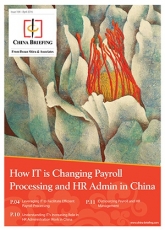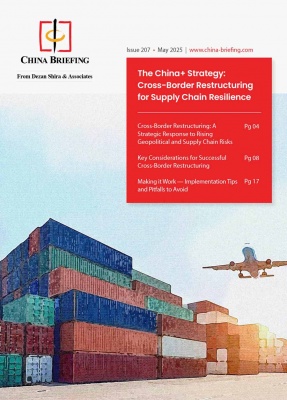Leveraging IT to Facilitate Efficient Payroll Processing in China
By Adam Livermore, Dezan Shira & Associates
Editors: Qian Zhou & Alexander Chipman Koty
Not so long ago, it was common for organizations in China to share input data for their monthly payroll with their payroll processing vendors across corporate email. It was also not unusual for those vendors to process their clients’ payroll using Excel sheets. Nowadays, the advent of secure FTP links to allow uploading and downloading of sensitive HR information has eliminated confidentiality concerns relating to data transmission. Payroll processing companies have also developed sophisticated systems to make payroll calculations and produce the reports their clients require, instead of fiddling with formulae in Excel. However, the gathering of input information has remained a significant challenge.
A good example of the complexity is the social insurance and housing fund systems in China. Contributions need to be made on behalf of every employee, but the administration of the systems is managed at city-level. Contribution percentages differ greatly between cities, and even within districts of the same city. The housing fund, in particular, presents a challenge. The entire amount of housing fund contribution from employers is considered tax-free when the salary of an employee is no more than 500 percent of the local average annual salary in some cities. In other cities, the tax-free housing fund contribution base is limited to 300 percent of the local average annual salary.
For the portion in excess of the limit, individual income tax should be imposed. This therefore affects payroll calculations. In addition, the average annual salary of workers in a particular city is, by definition, different across every city in China. Even the timing of the release of updated statistics about these figures changes each year. For payroll processing companies, obtaining accurate and up-to-date information from every city is a continuous challenge.
A more general and fundamental challenge for third party payroll processors is that HR as a discipline in China is not as advanced as it is in the U.S. or in a major European country. While HR managers tend to be administrators rather than communicators or strategists, the administration work that is done is usually paper-based. Absence application forms, overtime application forms, and sometimes even salary payments themselves are handled on paper directly between the HR team and the employees.
When a company utilizes a third-party payroll processor to manage payroll, accurately consolidating and transmitting this information to the payroll provider is difficult and time-consuming. The likelihood for error expands as details are transposed from paper documents into Excel sheets and then consolidated. This workload can actually be more time consuming that the payroll processing itself.
Because of the difficulties involved in the efficient gathering and transmitting of input information necessary for the payroll process, many companies decide to keep payroll processing as an internal function within their local organizations. Although many managers recognize the risks and the lack of efficiency inherent in using this method, they have not had attractive enough options from third party payroll providers to consider changing approaches.
![]() RELATED: Payroll and Human Resource Services
RELATED: Payroll and Human Resource Services
The Solution
The solution to these challenges is being provided through IT platforms. The largest multinationals, which have thousands or tens of thousands of employees in populous Asian countries, have internal solutions. They spend tens of millions of dollars on comprehensive ERP systems that cover almost every aspect of their operations in all the significant markets they are involved in, often including HR. They can afford to do this because the sheer number of employees that such a multinational has in a country like China justifies spending millions of dollars configuring their ERP system (typically SAP or Oracle). This allows it to deal with complexity in every significant market in which it operates. The huge costs involved in the development and maintenance of such a system can be justified by the company’s revenues in those markets. This is the ideal solution, as these companies are able to maintain all their operational information within one unified database.
The same luxury is not available to most multinational firms. Lacking the scale of the giants, they only have hundreds or dozens of employees in each of their Asian markets. Such companies typically operate ERP systems to manage their production, finance, inventory, etc. However, they seldom make the jump to managing their HR administration within their global ERP system. If they do, it is unusual that such companies will also attempt to make the payroll calculations for employees in each of those markets from the global ERP system. The configuration cost of their ERP system is too high to make it a sensible option.
It is for these companies that payroll processors are developing solutions. The key concept around which any solution needs to be built is the “HR hierarchy”. This is effectively a mapping of the reporting lines within an organization, containing every position within the organization and the employees that fill those positions. Please note that an organization can be defined to be one corporate entity in one country or multiple corporate entities across multiple countries.
Once an HR hierarchy has been built within a system, day-to-day issues like applications for annual leave can be managed through the system. Because the reporting line has been defined, an application by a particular employee is channeled to the appropriate manager for approval. The HR manager is automatically updated about pending approvals and can chase managers as necessary. Critically, this data may be directly utilized by the payroll processing company as an input for the monthly payroll process.
Management of statutory and annual leave is often complex. Systems are able to handle complexity, and as long as there is logic, the rules can be built into the system. Employees at the client organization go into an online interface to make applications and provide relevant data.
From the perspective of the payroll processor, the roadblock relating to the gathering of information from clients is removed through the provision of a system with an online interface for its clients to use. For instance:
Once data is inputted into a system, it can be accumulated and then analyzed. This is almost impossible to do with paper records. Comparisons for internal purposes can be made between employees, managers, and entities.
Many multinational organizations have expat managers that regularly travel globally. Sometimes they even manage multiple entities in Asia and are not physically based at one specific location full-time. The ability to go into an online system to make approvals for applications allows decision making to be accelerated and keeps the manager updated on the attendance status of the employees at each entity.
![]() RELATED: Understanding IT’s Increasing Role in HR Administration Work in China
RELATED: Understanding IT’s Increasing Role in HR Administration Work in China
Although the back-end of systems typically only operate in English, the interfaces which the employees see, and into which they enter data, can be displayed in the local language. This reduces misunderstanding and speeds up processes.
When problems arise internally or with the payroll provider, an audit trail is available for all stake-holders to see where responsibility lies for each particular problem.
Naturally, many complications emerge when setting up these systems and interfaces. One universal problem arises because every company has its own internal rules relating to the amount of annual leave, application for overtime, etc. Very often when implementing a system to manage these processes, it is identified that the internal regulations are not sufficient to cover every eventuality. In such situations, companies need to redefine their HR rules and regulations (encoded in the employee handbook) before configuring the system. Other complications may arise if the local company does not have sufficient bandwidth for their internet connection or adequate server/network equipment. Nevertheless, once implemented across multiple entities, the savings generated by the utilization of these system should be far greater than the implementation costs.
This approach is a more viable option for most multinationals that cannot extend themselves to building out a comprehensive internal ERP system across all the countries in which they operate. For the payroll processor, the main benefit of these systems is the fact that they provide a persuasive case to potential clients to use their services. However, the biggest benefits for the companies adopting systemized solutions may not be the greater efficiency of the payroll process itself. Rather, it comes from the increased speed of internal decision-making, and the ability to gather important HR data in a central location which can be analyzed to enable strategic decisions to be made relating to those entities.
 This article is an excerpt from the April issue of China Briefing Magazine, titled “How IT is Changing Payroll Processing and HR Admin in China.” In this issue of China Briefing, we examine how foreign multinationals can take better advantage of IT in the gathering, storing, and analyzing of HR information in China. We look at how IT can help foreign companies navigate China’s nuanced payroll processing regulations, explain how software platforms are becoming essential for HR, and finally answer questions on the efficacy of outsourcing payroll and HR in China. This article is an excerpt from the April issue of China Briefing Magazine, titled “How IT is Changing Payroll Processing and HR Admin in China.” In this issue of China Briefing, we examine how foreign multinationals can take better advantage of IT in the gathering, storing, and analyzing of HR information in China. We look at how IT can help foreign companies navigate China’s nuanced payroll processing regulations, explain how software platforms are becoming essential for HR, and finally answer questions on the efficacy of outsourcing payroll and HR in China. |

 Human Resources and Payroll in China 2015
Human Resources and Payroll in China 2015
This edition of Human Resources and Payroll in China, updated for 2015, provides a firm understanding of China’s laws and regulations related to human resources and payroll management – essential information for foreign investors looking to establish or already running a foreign-invested entity in China, local managers, and HR professionals needing to explain complex points of China’s labor policies.
 Labor Dispute Management in China
Labor Dispute Management in China
In this issue of China Briefing, we discuss how best to manage HR disputes in China. We begin by highlighting how China’s labor arbitration process – and its legal system in general – widely differs from the West, and then detail the labor disputes that foreign entities are likely to encounter when restructuring their China business. We conclude with a special feature from Business Advisory Manager Allan Xu, who explains the risks and procedures for terminating senior management in China.
 Internet Challenges & Solutions When Doing Business in China
Internet Challenges & Solutions When Doing Business in China
In this special edition of China Briefing magazine, we highlight how and why foreign companies will be negatively affected by China’s internet, and provide methods to help solve these problems. We discuss ISP selection, internet connection types, CDNs and VPNs, and internal control systems. Finally, we examine the importance of network security in China and how it can help augment a company’s internet connection.
- Previous Article Accessing China’s Third Party Mobile Payments Market: A Comparison of WeChat and Alipay
- Next Article Einhalten der rechtlichen Bestimmungen in China

























